-
 Snoflo Premium
Snoflo Premium
Get unlimited access to all our content
With no Ad interruptions! - Start Your Free Trial Login with existing account
Hite
Eden Index
Climate
8.3
•
Recreation
1.7
•
Community
1.3
•
Safeguard
4.2/10

Hite, Kentucky is a small town located in the eastern part of the state, known for its beautiful natural surroundings and outdoor recreational opportunities. The climate in Hite is characterized by mild summers and cold winters, with temperatures ranging from an average high of 86°F (30°C) in July to an average low of 24°F (-4°C) in January. The town experiences moderate rainfall throughout the year, providing adequate water resources for the region.
Hite is blessed with abundant hydrological constituents. The town is situated near the Licking River, providing opportunities for boating, fishing, and other water-based activities. The river is home to various fish species, making it a popular spot for anglers. Additionally, Hite is surrounded by lush green forests, offering opportunities for hiking, camping, and wildlife watching. The nearby Daniel Boone National Forest is a haven for outdoor enthusiasts, with its diverse landscapes, including mountains, caves, and waterfalls.
Overall, Hite, Kentucky offers a pleasant climate, ample water resources, and a range of outdoor recreation opportunities, making it an ideal destination for nature lovers and adventure seekers.
What is the Eden Index?
The Snoflo Eden Index serves as a comprehensive rating system for regions, evaluating their desirability through a holistic assessment of climate health, outdoor recreation opportunities, and natural disaster risk, acknowledging the profound impact of these factors on livability and well-being.
Climate Health Indicator (CHI): 8.3
Hite receives approximately
1122mm of rain per year,
with humidity levels near 85%
and air temperatures averaging around
13°C.
Hite has a plant hardyness factor of
6, meaning
plants and agriculture in this region thrive during a short period during spring and early summer. Most
plants will die off during the colder winter months.
By considering the ideal temperature range, reliable water supplies, clean air, and stable seasonal rain or snowpacks, the Climate Health Indicator (CHI) underscores the significance of a healthy climate as the foundation for quality living.
A healthy climate is paramount for ensuring a high quality of life and livability in a region, fostering both physical well-being and environmental harmony. This can be characterized by ideal temperatures, reliable access to water supplies, clean air, and consistent seasonal rain or snowpacks.
Weather Forecast
Streamflow Conditions
Big Sandy
Area Rivers
Big Sandy
Snowpack Depths
Big Sandy
Reservoir Storage Capacity
Big Sandy
Groundwater Levels
Recreational Opportunity Index (ROI): 1.7
The Recreational Opportunity Index (ROI) recognizes the value of outdoor recreational options, such as parks, hiking trails, camping sites, and fishing spots, while acknowledging that climate plays a pivotal role in ensuring the comfort and consistency of these experiences.
Access to outdoor recreational opportunities, encompassing activities such as parks, hiking, camping, and fishing, is crucial for overall well-being, and the climate plays a pivotal role in enabling and enhancing these experiences, ensuring that individuals can engage in nature-based activities comfortably and consistently.
Camping Areas
| Campground | Campsites | Reservations | Toilets | Showers | Elevation |
|---|---|---|---|---|---|
| Horse Creek Rec Area | 34 | 1,759 ft | |||
| Rocky Bluff | 30 | 1,753 ft | |||
| Davy Crockett Birthplace | 88 | 1,392 ft | |||
| High Knob | 77 | 3,608 ft | |||
| Houston Valley | None | 1,843 ft | |||
| Kinser Park | None | 1,314 ft | |||
| Paint Creek | 21 | 1,750 ft | |||
| Old Forge | 15 | 2,154 ft | |||
| Flag Rock Recreation Area | 21 | 2,461 ft | |||
| Natural Tunnel State Park | None | 1,703 ft |
Nearby Ski Areas
Catastrophe Safeguard Index (CSI):
The Catastrophe Safeguard Index (CSI) recognizes that natural disaster risk, encompassing floods, fires, hurricanes, and tornadoes, can drastically affect safety and the overall appeal of an area.
The level of natural disaster risk in a region significantly affects safety and the overall livability, with climate change amplifying these risks by potentially increasing the frequency and intensity of events like floods, fires, hurricanes, and tornadoes, thereby posing substantial challenges to community resilience and well-being.
Community Resilience Indicator (CRI): 1.3
The Community Resilience Indicator (CRI) recognizes that education, healthcare, and socioeconomics are crucial to the well-being of a region. The CRI acknowledges the profound impact of these elements on residents' overall quality of life. By evaluating educational resources, healthcare accessibility, and economic inclusivity, the index captures the essential aspects that contribute to a thriving community, fostering resident satisfaction, equity, and social cohesion.

